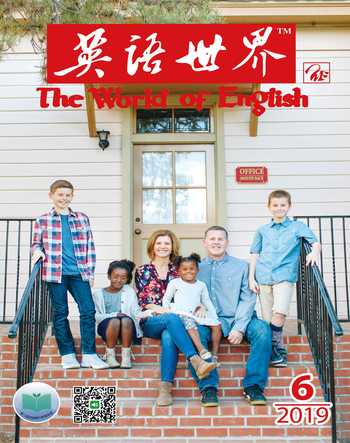Myths About Adoption vs.Adoption Facts关于收养的谬见与事实
贾利云
If you’re considering adoption for yourself, or want to debunk1 some common myths for family and friends, we explain what’s fact and what’s fiction2.
Myth: Birth mothers are typically3 young, immature teenagers.
Fact: More than half of the births in the United States are to single or married women under the age of 45. Although teenagers make adoption plans, a large percentage of birth mothers are women in their 20’s, 30’s, or 40’s and many are moms raising other children. Placing a child for adoption takes a great deal of love, courage, and maturity. Birth mothers choose adoption because they want to give their child a chance at life. Birth mothers are encouraged to take an active role in making an adoption plan.
Myth: Adoption is a selfish, easy solution—for an unexpected pregnancy—made by expectant parents4 who don’t care about their child.
Fact: Birth parents choosing adoption are making a loving, courageous parenting decision. This option allows them to give a child life and fulfil their parenting responsibilities. In order to do this, they must put their own needs aside in order to focus on what is best for the child. Adoption is by no means taking the easy way out. It is a difficult decision, and birth parents deserve to have people around them who support their choices; Support can come from family and friends, or from adoption counselors and other professionals.
Myth: No one can love a child as much as a birth mother or birth father does.
Fact: Adoptive parents can love their child as fully and selflessly as biological parents5 can. Studies show that adopted children report feeling very loved by adoptive parents and never doubt that love. The absence of biological connection does not determine the adoptive parents’ love for their children. Because adoptive parents are strongly encouraged to be honest with their children about their adoption, most children grow up with the knowledge that they were loved very much by both their birth parents and adoptive parents.
Myth: The birth mother will regret her decision for the rest of her life and have serious emotional problems.
Fact: Birth mothers who understand that the adoption decision gives their child a stable future of opportunity and love, and who receive counseling before and after making an adoption plan, can live the rest of their lives knowing they’ve given their child a very special gift.
Myth: Adoption is a more traumatic experience for a woman than abortion.
Fact: With an abortion, the pain of deep regret may continue for a lifetime. Adoption, when understood correctly, is initially painful but it can be followed by a lifetime of satisfaction for having given her child a chance at life.
Myth: The adoption process is secretive6 and a birth parent will never know anything about their child and their adoptive parents in the following years.
Fact: Adoption has changed over the years. Now birth families can select the child’s adoptive family, meet the adoptive family, receive on-going information about the child, receive pictures on a regular basis and, in some cases, have visits with the child and adoptive family.
Myth: A birth family will eventually forget about the child for whom they made an adoption plan.
Fact: A birth family making an adoption plan will never forget. They will not want to forget. What they can do is continue on with their life without being emotionally crippled7 by their loss. When they do remember, they can remember that they made the most loving, mature and selfless decision possible.
Myth: Adoption damages the child.
Fact: Studies show that adopted and non-adopted children are not different in adjustment, delinquency8 or mental health. Adopted teenagers are as emotionally stable as non-adopted teenagers. Adopted individuals do not have more family problems than non-adopted people. The child can grow up knowing that his/her family was created by adoption and understanding that his/her birth mother selflessly planned a wonderful future for her child. The child can be grateful for the birth parents’ choice of adoption.
Myth: Open adoption9 is confusing to children and a form of co-parenting10.
Fact: Children in open adoptions are not confused by contact with their birth parents. Even at an early age, children can understand the different roles of their adoptive families and birth families: birth parents gave them life and adoptive parents care for and nurture them. In open adoption, the line between family members is clearly defined. The adoptive parents and birth parents do not have shared custody11. Adoptive parents are responsible for all of decisions relating to their child’s welfare. Birth parents may be involved in the children’s lives, but they do not have legal rights or responsibilities for the child.
Myth: Adoptive parents often break their openness agreements12 with their child’s birth parents.
Fact: It’s true that not every adoption agreement goes as smoothly as planned. However, adoptive parents who have been properly counseled understand the benefits of maintaining an ongoing relationship with their child’s birth parents, and are more likely to adhere to the arrangement.
Myth: Placing a child with a family of another race or ethnicity is bound to cause problems for the child.
Fact: More than fifty years of research on transracial and transcultural adoptions, as well as research on Black children adopted by Caucasian13 parents, disproves this myth. Trans-racially and trans-culturally adopted children usually adjust well, with strong racial identity, self-esteem, and attachment to their family.
如果你正在考慮收养小孩,或想向家人和朋友澄清关于收养的一些常见谬见,本文为你辨明真相、消除误解。
谬见:生母通常是不成熟的青少年。
事实:美国一半以上的新生儿母亲是45岁以下的单身或已婚女性。虽然计划送养小孩的生母中有青少年,但大部分是二三十岁或三四十岁的女性,其中许多人育有多个子女。决定送养小孩需要满满的爱、巨大的勇气且足够成熟。生母做此决定是因为她们想给孩子提供更好的人生机会。生母被鼓励积极参与送养计划。
谬见:送养是不在乎孩子的准父母因意外怀孕作出的自私而轻率的决定。
事实:送养小孩是亲生父母作出的一个出于爱、有勇气的决定。这一选择给了孩子新生,也让他们完成了养育孩子的责任。要做到这一点,他们必须将自己的需求放到一边,而专注于什么对孩子是最好的。送养并非为了逃避困难,而是艰难作出的选择,亲生父母需要身边有人支持他们的决定,可寻求来自亲友或领养顾问等专业人士的支持。
谬见:没人能像亲生母亲或亲生父亲那么爱孩子。
事实:养父母也能像亲生父母那样全心全意、无私无求地爱孩子。研究显示,领养的孩子感受到养父母对他们的深深关爱,他们也从不怀疑那份爱。没有血缘关系不会影响养父母对孩子的爱。因为强烈鼓励养父母就领养之事对孩子坦承相告,所以大多数孩子在成长过程中就知道,亲生父母和养父母都很爱他们。
谬见:生母余生都会后悔将孩子送养,并产生严重的情感问题。
事实:生母如果理解送养是给孩子提供一个充满机会和爱的稳定的未来,并在制订送养计划前后都接受咨询,知道她们给了孩子一份非常特殊的礼物,有生之年也能有所慰藉。
谬见:对女性来说,送养带来的创伤比堕胎更大。
事实:因堕胎而深感悔恨,这种痛苦会持续一生,而若对送养有正确的认识,开始可能会感到痛苦,但以后会因为给孩子提供了新的人生机会而感到满足。
谬见:收养程序是保密的,且在以后的日子里,亲生父母永远不会知道他们孩子和养父母的任何消息。
事实:多年来,收养制度发生了很大变化。现在,亲生父母可以选择让什么样的家庭收养他们的孩子、和收养家庭见面、持续了解孩子的情况、定期收到孩子的照片,有些情况下还可以看望孩子、拜访收养家庭。
谬见:亲生父母最终会忘记他们送养的孩子。
事实:作出送养小孩决定的亲生父母永远不会忘记,他们也不想忘记。他们能做的就是继续他们的生活,不因孩子的离开而产生严重的情感问题。当他们回想起来时,记得的是他们满怀爱意做了最成熟、最无私的决定。
谬见:领养会给孩子造成伤害。
事实:研究表明,领养的孩子和非领养的孩子在调整适应、违法犯罪和心理健康上没有差别。领养的青少年和非领养的青少年在情感上一样稳定。与非领养人群相比,领养人群并没有更多家庭问题。孩子成长的过程中,知道他/她是被收养的,理解他/她的亲生母亲无私地为自己规划了一个美好的未来,会感激亲生父母当初送养的决定。
谬见:开放式收养是一种共同养育的方式,会让孩子感到困惑。
事实:开放式收养的孩子不会因和亲生父母保持联络而感到困惑。即使在很小的时候,孩子也能理解他们的养父母和亲生父母承担着不同的角色:亲生父母给予他们生命,养父母关爱、养育他们。在开放式收养中,家庭成员的分界是很明确的。养父母和亲生父母并非共同享有对孩子的监护权。养父母全权决定抚养孩子的相关事务,亲生父母虽然参与孩子的生活,但在法律上没有权利,也无须承担责任。
谬见:养父母常常不遵守和亲生父母签署的开放式收养协议。
事实:虽然不是所有的收养协议都会得到顺利执行,但在收养问题上受过专业指导的养父母会明白,和孩子的亲生父母持续保持联系是有好处的,他们更可能遵守协议。
谬见:把小孩送给另一种族或民族的家庭收养必然会对孩子产生不良影响。
事实:50多年的跨种族和跨文化收养研究以及对被白人父母收养的黑人小孩的研究打破了这个谬见。跨种族和跨文化领养的孩子通常能很好地调整自己,有很强的种族认同意识、自尊心和家庭观念。
(译者为“《英语世界》杯”翻译大赛获奖选手)

